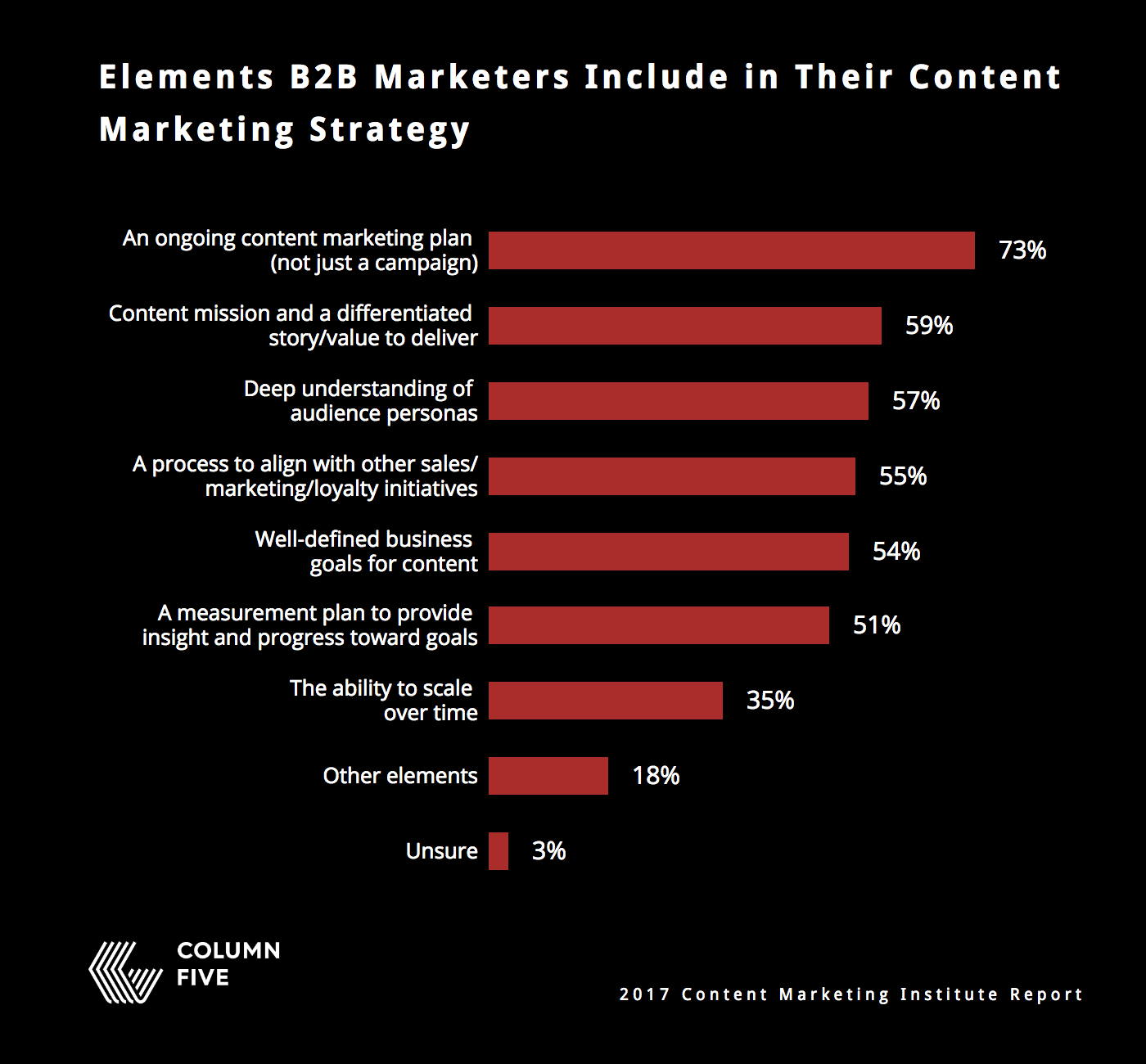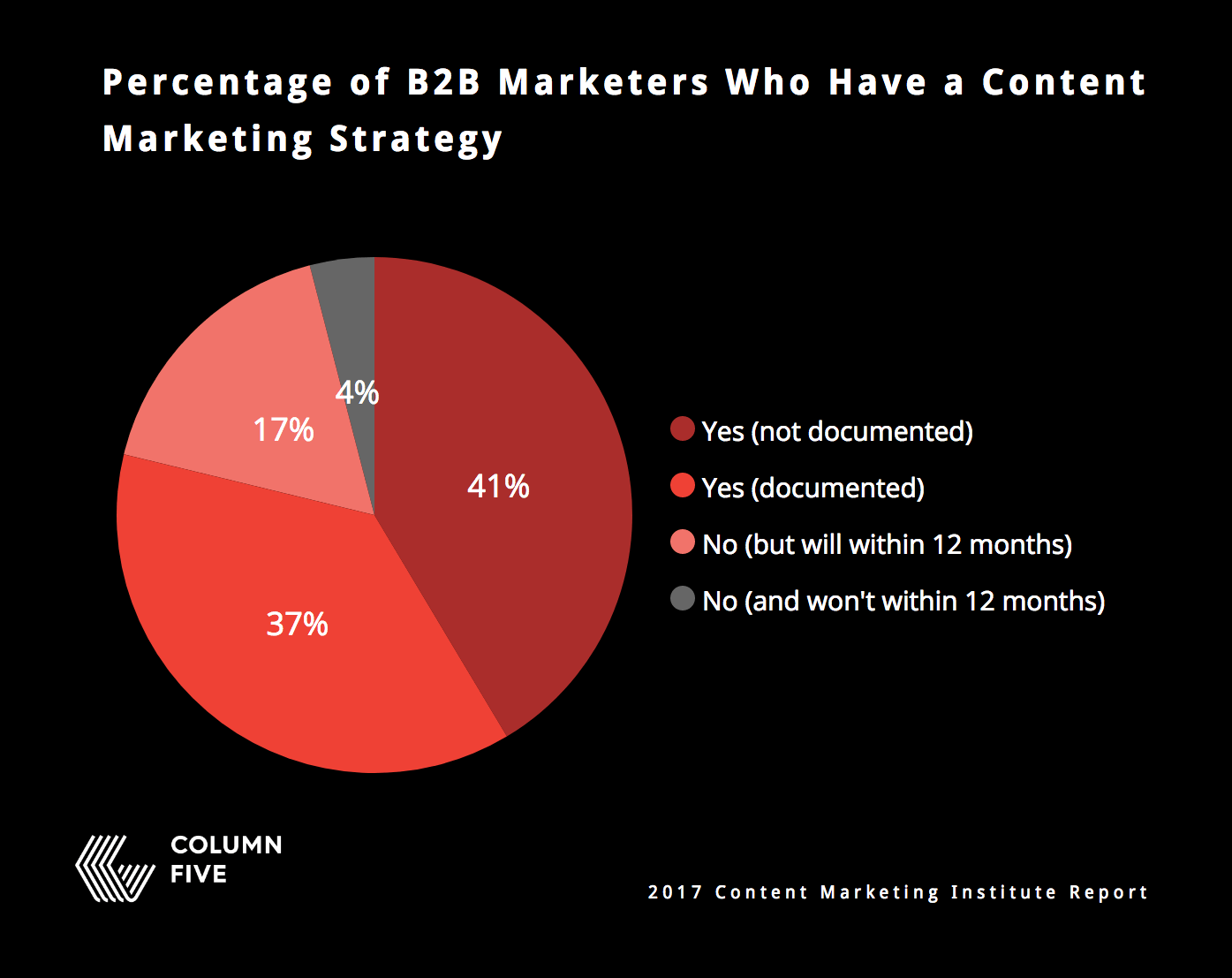Content marketing has proven to be an effective part of a brand’s marketing mix, but doing it well requires more than creating content and putting it out there. It’s not about churning out a few infographics and hoping for the best. The secret to good content marketing is good storytelling—telling the right stories, to the right people, in the right formats. It’s about creating value-driven content that connects with people and moves them along the buyer’s journey. To do it well, you can’t rely on what you “think” that might be. You need a solid content strategy plan to guide you.
But according to the Content Marketing Institute’s 2017 B2B Benchmarks report, only 37% of marketers have a documented content strategy. (Don’t confuse a full editorial calendar for a content strategy.)
While not ideal, this is understandable, as many marketers feel tremendous pressure to amp up content, foregoing quality for quantity to maintain a foothold in a content-saturated world. (Many brands come to us knowing they need a strategy, but first they say they need to knock out something they can put in the market.) But this content-saturated era is exactly why no marketer can work effectively without a content strategy.
How a Content Strategy Plan Transforms Your Marketing
Stumbling around in the dark, making decisions based on a hunch, trying a new format just because it’s new—do these sound familiar? Hopefully not, because they’re all-too-common symptoms of the most ineffective and expensive ways to create content. And if your content hasn’t been nearly as successful as you anticipated, you’re probably guilty of one or all of these things.
If you want to work more effectively, more economically, and more sanely, here’s how a content strategy can help every aspect of your content marketing process.

1) Know Who You’re Trying to Reach
Your content can’t make an impact if people don’t care about it. You need to know what will strike a chord with people. That means you need to learn more about the people you’re trying to reach.
A content strategy fills in the gaps here, pushing you to define (and document) who they are, what motivates them, where they are in the buyer’s journey, and what problems you can help them solve through content. It also helps you identify the right channels to reach them, so that you can identify not just the stories to tell but the formats that will resonate best.
Over time, your content performance will help you refine your documented strategy, getting you closer to having an intimate understanding of your target personas. (Find out more about how to make valuable content.)
2) Define Measurable Goals
How many times have you had or witnessed a frustrating conversation among your content team that boiled down to people having different expectations of what success is and how to define it? It might be the most common root of problems that content teams face, and the absence of a content strategy will leave you susceptible to this common but avoidable time-waster.
To make sure you’re doing the right thing and all moving parts are aligned to a single purpose, you need a map. A documented content strategy helps you identify KPIs and set “goalposts” to maintain accountability and measurement standards. (As habits researcher Gretchen Rubin notes, “you can only manage what you measure.”) This can include:
- Goals and Definitions
- Journey or Lead Mapping
- Budget Allocation
- Channel Opportunities
- Editorial Calendar
- Keyword Strategy
- Media Planning
- Tech Stack
- Measurement Methodology
You may need to shift your strategy in the future, but knowing what to report on and how to define success will unite your team toward your end goals.

3) Test and Tinker
Some people assume a documented content strategy is set in stone, but it is there so that you can see the clear picture and make adjustments at checkpoints. Whether it’s experimenting with social posting times, blog word count, or publishing cadence, having that base foundation takes care of the “big stuff” and lets you build on top of it by testing and tweaking your approach more intentionally.
Additionally, a documented strategy helps you track your own thinking and strategy. The more you test, the smarter you get.
4) Justify Your Decisions
Marketers face a lot of pressure. Managing a team, creating consistent content, and answering to higher-ups means you have to make a lot of decisions—and you have to be accountable to those decisions.
A strong content strategy helps you clarify your thinking and provides a foundation (ideally with evidence like A/B test results) when someone questions a decision. This reduces conflict, eliminates ego (as decisions are clearly rooted in consensus and/or data), and guides you with legitimate insights instead of best guesses. It can also help you get more support from higher-ups, whether you’re asking for more budget or want the green light to experiment with something totally new.
5) Work Efficiently and Economically
Ineffective planning costs a ton of time, resources, and energy. And when you’re creating content on the fly, those costs can get inflated. Tight timelines cause your team even more stress, a missed deadline can derail a creative project, and a final round of feedback—right before you’re about to publish a new infographic—can make you crazy. A content strategy helps avoid all these issues by letting you:
- Assess workload ahead of time and delegate in-house or contract outside vendors.
- Create a manageable timeline to maintain regular cadence.
- Plan your budget efficiently and spot opportunities to save costs or get more value out of content.
All of these benefits will help you work more efficiently and, most importantly, rest easy with the confidence that you’re using your resources wisely.
6) Protect Your Brand
Content production takes a lot of people and moving parts. It’s very easy for things to slip through the cracks, especially when you’re working with outside vendors. Whether it’s the story, the objective, the brand identity, or the language you use, a documented content strategy will keep everyone on the same page. That way you know all content will be high-quality, consistent, and on-brand, without you needing to micromanage every detail.
How to Craft a Content Strategy Plan
Crafting a content strategy can feel overwhelming, and it does take time. You might have to hit the pause button on your content machine, reallocate some funds, or ask your team to completely challenge the way they think about—and do—their work. But it’s crucial to do so to provide clarity, create a measurable framework, and empower your team to work more effectively. And that’s the key to great content marketing.
For more tips on creating an effective content strategy:
- Use our guide to build a strong content strategy.
- Experiment with a divisible content strategy to get more bang for your buck.s
- Find out the 10 content strategy lessons we learned the hard way.
If you still need some help, find out what it’s like to work with us or hit us up.






